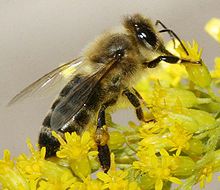Worker (bees)


Female honeybees , bumblebees , wasps and hornets are workers . All of these state-forming species from the order of the hymenoptera (Hymenoptera) have three different beings ( morphs ): queen , worker and drone .
Workers in the bee colony
Most of the members of a bee colony are workers. These are females whose sexuality is inhibited by the ongoing release of pheromones from the queen bee . Furthermore, the nutrition and care in the larval stage decide which animal will only become a worker or which will become a queen.
development
Note: Strictly speaking, the data given below only apply to some breeds of Western honeybees . There are in some cases considerable deviations in the other honey bee species and also in the African breeds of this species.
The development times of queen, drone and worker are of different lengths. The development is divided into three periods:
- Time as an egg - three days for all three bees
- Time as a larva in an open honeycomb cell - six more days, queen only five days. The larvae are fed intensively during this time. The weight gain in worker larvae is around a factor of 1000.
- Time in the sealed cell. The larva pupates several times, see also metamorphosis . This phase is shortest for the queen with 7 additional days and the longest for the drone with 15 days. In between, the worker lies with 12 days.
Thus, the overall development time (resulting from the oviposition to hatch as a finished, adult adult ) insect with 21 days for the worker.
activities
The worker's activities depend mainly on her age. Soon after hatching, it begins cleaning up the cells from which young bees have just hatched.
| Day of life | Tasks in the bee colony |
|---|---|
| 1st to 3rd day | Cleansing the cells from which bees have hatched. Provides the cells with a thin film of propolis to prepare them for the queen to lay new eggs |
| 4th to 5th day | Preparation of pollen food for the larvae and their care |
| 6th to 13th day | Forage glands are developed in the bee's head. Supplying the very youngest larvae and supplying the queen with food juice |
| 14th to 16th day | Excretion of wax, construction of honeycombs and capping of the brood |
| 17th to 19th day | Guard bee at the entrance of the beehive. Preparation for the honey bee. Feed juice u. Wax glands recede |
| from the 21st day | Exclusive activity: collects pollen, propolis, water and nectar |
Accordingly, use this table beekeepers also the following designations for workers: Ammenbiene , Stock bee , Baubiene , guardian , flying bee , collector , scout , track bee , Wasserholerin .
There are other factors that have an influence on the activities of individual bees in the bee colony as a whole . The need for activities can vary greatly due to the most diverse internal and external conditions and influences on the bee colony. Examples are the annual cycle, the swarm instinct , bee poisoning with the loss of many forager bees, etc. In addition, the bees of a colony also have different genes (see wedding flight ), which leads to specializations. Finally, even slightly different temperatures during the larval stage of a worker lead to different skills. An example of specialization and special skills are the "heater bees", which ensure that the brood nest is constantly heated to around 35 ° C.
During the growing season, a worker is no more than 45 days old. In contrast, the so-called winter bees are getting significantly older. This is the last brood raised in autumn. Your task is to overwinter and start again with brood care in spring. To do this, they have a body's own protein supply, which they consume before pollen can be collected. If there is a severe cold snap during this time (February), hatching is stopped and young larvae are eaten. This allows part of the protein to be stored back.
Web links
Individual evidence
- ^ Jürgen Tautz : The honeybee phenomenon. With photographs by Helga R. Heilmann. Elsevier, Spektrum Akademischer Verlag, Munich 2007, ISBN 978-3-8274-1845-6 .